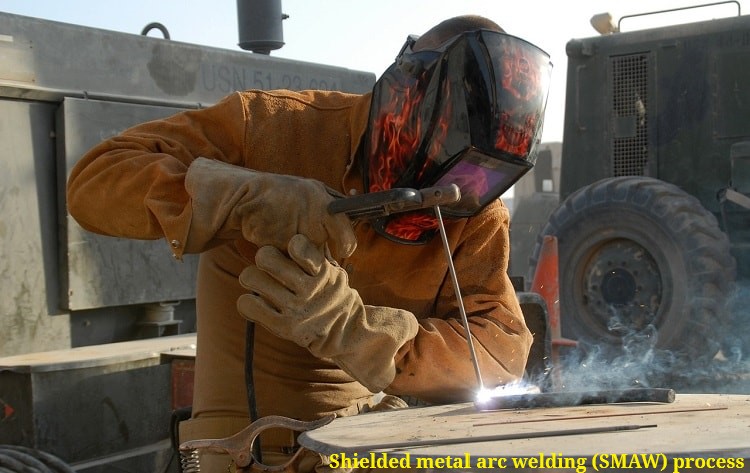Manual metal arc welding faults welding (weldingwelder.blogspot.com)
The defects commonly encountered in MMAW are:
. weld cracking
. porosity
. slag inclusions
. lack of fusion
. insufficient or excessive penetration
. contour faults
. undercut
. excessive spatter
. stray arcing.
. welding Cracking
Cracking is considered to be a serious weld fault and rarely is any amount of cracking tolerated. Cracks may be described depending on how, when and where they occur, eg longitudinal, transverse, crater, centre line, hot, cold, toe and under bead. Cracks may occur in either the parent metal, usually as fusion or heat affected zone cracks, or in the weld metal.
. Hot cracking − Usually occurs in metals that are hot, short and/or have high rates of thermal expansion. Hot cracking most commonly occurs in the weld metal with the most common examples being longitudinal and crater cracks.
. Cold cracking − Most commonly occurs in the base metal adjacent to the fusion zone. The most common example of this is under bead cracking in hardenable steels.
. Crater cracks − These come from hot shrinkage. The crater solidifies around all sides toward the centre, leading to a high concentration of stress at the centre of the crater. If the metal lacks ductility, or the hollow crater cannot accommodate the shrinkage, cracking may result. Crater cracks may, under stress, spread from the crater and lead to failure of the weldment. Cracking in MMAW welds on mild steel is generally not a major problem.
. weld Porosity
Porosity in MMAW welds can be the result of welding on a parent metal that is susceptible to this condition (such as steel that contains high amounts of dissolved gases or sulphur). Porosity may also be caused by welding on dirty material or material contaminated with moisture, oil, paint or grease. The electrode may have been contaminated, or too much current or too long an arc length used.
. welding Slag inclusions
Slag inclusions in MMAW can occur at the weld root; between weld runs, or on the weld surface. They generally occur in MMAW as a result of low amperage, poor electrode manipulation, working on dirty or contaminated metal, or incorrect joint preparation.
. Lack of fusion/lack of root penetration
With MMAW, lack of fusion or lack of root penetration is commonly caused by low amperage, working on dirty or contaminated material or using the wrong joint configuration, electrode angle or travel rate.
. Excessive penetration welding (weldingwelder.blogspot.com)
Excess weld metal protruding through the root of a butt weld may occur in MMAW because of incorrect joint preparation, wrong electrode choice, excessive amperage or incorrect variables.
. Contour defects
Contour defects may be in the form of insufficient or excessive leg size, overroll or overlap, excessive convexity or concavity of the bead, or simply a rough, uneven
appearance.
These are mainly caused by the operator but by using the correct electrode, amperage, travel speed and electrode angle adjustments, many of these problems can be fixed.
. Undercut
Undercut in MMAW is defined as a groove or channel in the parent metal, occurring continuously or intermittently along the toes or edge of a weld.Undercut is a common problem in MMAW and can be caused by excessive amperage, too long an arc length, wrong electrode angles, or wrong travel rate.
. Excessive spatter
Although some spatter is a normal part of MMAW, excessive spatter is ugly and difficult to remove. Some electrode types produce more spatter than others, but generally excessive spatter is caused by high amperage or too long an arc length.
. Stray arcing
Defined as damage to the parent metal resulting from the accidental striking of an arc away from the weld. Even though stray arcing is not a major problem associated with the MMAW of mild steel, it is good practice to take precautions against accidental arcing of the electrode anywhere other than in the weld zone.

